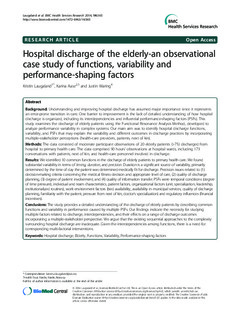| dc.description.abstract | Background: Understanding and improving hospital discharge has assumed major importance since it represents an error-prone transition in care. One barrier to improvement is the lack of detailed understanding of how hospital discharge is organized, including its interdependencies and influential performance-shaping factors (PSFs). This study examines the discharge of elderly patients using the Functional Resonance Analysis Method, developed to analyze performance variability in complex systems. Our main aim was to identify hospital discharge functions, variability, and PSFs that may explain the variability and different outcomes in discharge practices by incorporating multiple-stakeholder perceptions (health-care providers, patients, next of kin).
Methods: The data consisted of moderate participant observations of 20 elderly patients (>75) discharged from hospital to primary health care. The data comprised 90 hours’ observations at hospital wards, including 173 conversations with patients, next of kin, and health-care personnel involved in discharge.
Results: We identified 10 common functions in the discharge of elderly patients to primary health care. We found substantial variability in terms of timing, duration, and precision. Duration is a significant source of variability, primarily determined by the time of day the patient was determined medically fit for discharge. Precision issues related to (1) decision-making criteria concerning the medical fitness decision and appropriate level of care, (2) quality of discharge planning, (3) degree of patient involvement, and (4) quality of information transfer. PSFs were temporal conditions (degree of time pressure), individual and team characteristics, patient factors, organizational factors (unit, specialization, leadership, institutionalized routines), work environment factors (bed availability, availability in municipal services, quality of discharge planning, familiarity with the patient, pressure from next of kin, doctor’s specialization) and regulatory influences (financial incentives).
Conclusions: The study provides a detailed understanding of the discharge of elderly patients by describing common functions and variability in performance caused by multiple PSFs. Our findings indicate the necessity for studying multiple factors related to discharge, interdependencies, and their effects on a range of discharge outcomes incorporating a multiple-stakeholder perspective. We argue that the existing sequential approaches to the complexity surrounding hospital discharge are inadequate. Given the interdependencies among functions, there is a need for corresponding multi-factorial interventions. | nb_NO |

